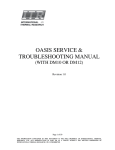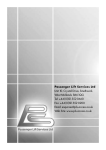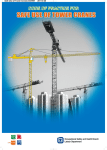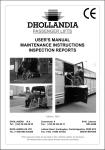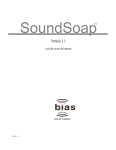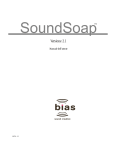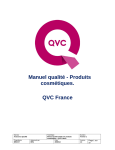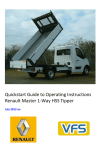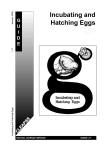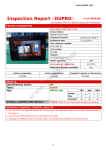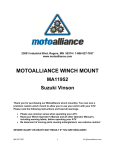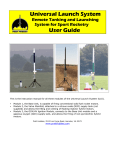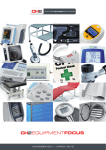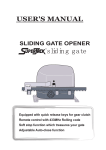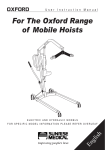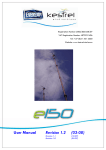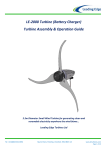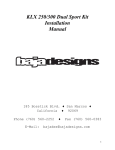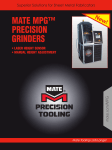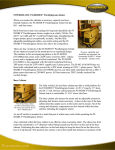Download Access Operation & Maintenance Manual
Transcript
PLS Access Op & Main Manual 2014 12/06/2014 13:31 Page 1 Access Operation & Maintenance Manual (including Mega Lift) Tel: +44 (0)121 552 0660 www.passengerliftservices.co.uk PLS Access Op & Main Manual 2014 12/06/2014 13:31 Page 2 Issue 1.3 March 2010 This document is the exclusive property of ‘PASSENGER LIFT SERVICES’ and is copyright in which all rights are reserved, no copy of this document can be made without the written authority of the proprietors of the copyright. Written and complied by: A. Beck B.Sc. CAD work by: T. Urbanski M.Sc, G. Fisher, P. Edwards Technical contributions from: D. Wheatcroft, P. Edwards & A. Tompkins PLS Access Op & Main Manual 2014 12/06/2014 13:31 Page 3 Information Section 1 PLS Access Op & Main Manual 2014 12/06/2014 13:31 Page 4 IMPORTANT The new lift owner/operator should refer to this manual for operating instructions, future warranty and servicing work. This manual should be kept safely for the entire working life of the lift. When quoting the lift serial number to the manufacturers, this number can be found in the top right hand corner of the S.W.L. sticker located on the roll-off ramp. The number is also stamped into the aluminium platform main section (near side). PLS Access Op & Main Manual 2014 12/06/2014 13:31 Page 5 Contents Section 1 2 Page Information Warranty terms & conditions Access Lift technical data LOLER information Safety instructions Safety instructions for scooters and large – Powered wheelchairs Access Semi-Auto operating procedure Access Powermatic operating procedure Mega coach lift operating procedure Hydraulic bridge plate manual override Savery hand pump operating procedure Monarch hand pump operating procedure PLS Lift daily check sheet Service record sheet Monthly safety checks 6 monthly safety checks Lift trouble shooting Floor height adjustment How to set the bridge plate mechanism Lubrication diagram Decal (sticker) diagram Hand set layout 1.06 1.07 1.08 1.09 1.10 1.11 1.12 1.13 1.14 1.15 1.16 1.17 – 1.18 1.19 1.20 1.21 1.22 – 1.23 1.24 Ordering spare parts (drawings) Spare parts order form Lift assembly drawing Flatback box drawing Stepback box drawing Standard carriage assembly Mega carriage assembly Standard box lock In/out motor assembly Standard arm assembly Mega arm assembly Standard platform assembly Double bridge plate mechanism platform Hydraulic bridge plate mechanism platform Hydraulic elements for bridge plate mechanism Standard handrail assembly Bridge plate assembly 2.01 2.02 2.03 2.05 2.07 2.09 2.11 2.12 2.13 2.14 2.15 2.17 2.19 2.21 2.22 2.23 1.01 1.02 1.03 – 1.04 1.05 – – – – 2.04 2.06 2.08 2.10 – 2.16 – 2.18 – 2.20 – 2.24 PLS Access Op & Main Manual 2014 12/06/2014 13:31 Page 6 Contents cont... Mega handrail assembly Standard roll-off ramp assembly Oil control pump assembly Savery pump assembly 2.25 2.26 2.27 2.28 3 Hydraulic section Access lift hydraulic schematic 3.01 Lift with hydraulic bridge plate schematic 3.02 Roll-off ramp cylinder 3.03 Bridge plate cylinder 3.04 Lifting cylinder assembly 3.05 Standard lifting cylinder 3.06 Hybrid lifting cylinder 3.07 Short mega lifting cylinder 3.08 Mega lifting cylinder 3.09 Long mega lifting cylinder 3.10 Layout of hydraulic hoses 3.11 Layout of hydraulic hose for hydro bridge plate 3.12 Hose identification 3.13 – 3.14 4 Electrical section Powermatic pump wiring diagram Powermatic carriage loom diagram Hydraulic bridge plate electrical diagram Hydraulic bridge plate carriage loom Hydraulic bridge plate platform loom Hydraulic bridge plate control units 4.01 4.02 4.03 4.04 4.05 4.06 Lift installation & testing section Fitting sequence Load testing a fitted lift Bracket fit to box section chassis Bracket fit to open section chassis Umbilical positioning Solenoid and relay types PLS recommended torque settings LOLER certificate Weight test certificate Welding information 5.01 – 506 5.07 5.08 – 5.09 5.10 – 5.11 5.12 5.13 5.14 5.15 5.16 5.17 Part numbers section Lift parts reference guide 6.01 – 6.04 5 6 PLS Access Op & Main Manual 2014 12/06/2014 13:31 Page 7 WARRANTY TERMS & CONDITIONS Warranty Cover & Period The P.L.S. warranty covers parts and labour, and is effective for 36 months from date of commission by P.L.S. Procedure 1 2 3 An operator requiring attention to a unit would contact P.L.S. quoting serial number. P.L.S. will instruct either the factory Service Department, or contact an appointed Service Agent issuing an official order number to effect the repair. All parts will be issued free of charge subject to the return of the faulty components. N.B. Any work carried out or charges generated without authorisation will not be reimbursed. Conditions 1 2 3 4 5 6 7 8 Warranty does not extend to units, which have not been regularly serviced by duly appointed personnel. Including a 6 monthly LOLER certification. All warranty work must be carried out by factory appointed personnel using approved parts and materials. The units must be made available for repair during normal working hours (08.00-17.00 Hours Monday to Friday excluding public holidays). No delivery costs or travel time will be reimbursed except by prior agreement and as specified on the official order. Warranty does not include the cost of: a Consumable parts i.e. fuses, bulbs and electrical connections. b Driver misuse. c Accident damage. d Items, which are subject to the level of, wear which would normally involve replacement during normal service and maintenance operations. No claim will be accepted for: a Replacement vehicle hire. b Loss of earnings. The warranty agreement does not supersede the suppliers liability for all components defined in the Sales of Goods Act 1979 and the supply of Goods Act 1982. Months 24 to 36 of the warranty require the vehicle to be returned to PLS for Free of charge warranty work. Otherwise labour and travel time will be charged at £40 per hour. 1.01 PLS Access Op & Main Manual 2014 12/06/2014 13:31 Page 8 Access Lift Technical Data The lift is designed to transport: One person in a wheelchair with or without an attendant, with a size not larger than the width/length of platform space available, or weight over the stated badge capacity (300Kgs unless upgraded by PLS). Or Two walking passengers. The operator should not attempt to transport more than two people at a time because of increased risk of passenger discomfort. The passengers also may require extra space for mobility devices such as walking sticks and frames. Capacity: Standard Lift = 300Kgs (possible upgrade to 350Kgs available by special request) Specifications: Lift type Voltage Power system Hydraulic fluid type Control Bridge-plate width Platform width Platform length Weight of lift (inc pump module) Working pressure Max amp draw at pump Safety systems 1.02 :Underfloor cassette :12Volts standard (24Volts available) :Electro-hydraulic pump. :PLS Blue (specific formulation) or ATF :Pendant via wanderlead :680mm or 730mm or 780mm (usable) :725mm or 775mm or 825mm :1240mm or 1410mm to 1780mm :137Kgs to 234Kgs :170 Bar MAX :75 amps :Dead man button control :Platform roll-off barrier (ramp) :Bridging plate :Main power isolation switch :& or Driver isolation switch :Hose valves fitted inside cylinder body :Hydraulic hoses rated x 4 :Stow position warning light (optional) :Flashing LED side light pods x 2 (optional) PLS Access Op & Main Manual 2014 12/06/2014 13:31 Page 9 Important Information LOLER ‘98 What is LOLER? The Lift Operations and Lifting Equipment Regulations 1998 which came into force on 5th December 1998. Basically LOLER replaced existing legal requirements relating to the use of Lifting equipment. What does LOLER do? The Regulations require that lifting equipment provided for use at work is: 1 Strong and stable enough for the particular use and correctly marked to indicate safe working loads. 2 Used safely in a planned and organised way by Competent People. 3 Examined, inspected and tested on a regular basis by Competent People. How can PLS help? Passenger Lift Services offer a Bi-Annual examination and weight testing programme carried out only by PLS Approved engineers. Each certificate is individually numbered and security marked to ensure authenticity. To begin your programme of compliance with LOLER ‘98 call now on: 0121 552 5503 What equipment does LOLER cover? All equipment used at work for lifting or lowering loads. Who do the regulations affect? Any person responsible for providing or having control over the provision of lifting equipment in the workplace - the duty holder. What should the duty holder be aware of? The Health and Safety Executive (HSE) have produced a publication - ‘The Safe Use of Lifting Equipment’ lifting operations and lifting regulations 1998 approved code of practice and guidance (APCPG). How do I obtain a copy of this publication? By mail order from: HSE Books, PO Box 1999, Sudbury, Suffolk, CO10 6FS Tel: 01787 881165 Fax: 01787 313995 What do the regulations require me to do? The regulations impose a number of requirements on the duty holder including ensuring that: • The lift operations are carried out and supervised in a safe manner by Competent People. 1.03 PLS Access Op & Main Manual 2014 12/06/2014 13:31 Page 10 What do the regulations require me to do? The regulations impose a number of requirements on the duty holder including ensuring that: • The lift operations are carried out and supervised in a safe manner by Competent People. • Where equipment is used for lifting people it is suitably marked and safe for the purpose. • Before the lifting equipment is used for the first time it is thoroughly examined by a Competent Person and thereafter at regular intervals. Who Qualifies as a Competent Person? A person who has appropriate practical and theoretical knowledge and experience for the lifting equipment to be examined to enable them too detect actual or potential defects or weaknesses and to asses their importance in relation to the equipment and it’s installation. i.e. A person holding a service training certificate by the manufacturer. It is essential that the competent person is sufficiently independent and impartial to allow objective decisions to be made. Does this mean the competent person must be employed by an outside company? No BUT if in-house examiners are used you must ensure that their total impartiality to carry out the examination(s) without ‘fear or favour’. Are the regular intervals specified? YES - but you have a choice - you can follow the specified period intervals of at least six months for equipment used for lifting people or You can have a examination scheme drawn up and have the equipment examined in accordance with this scheme. Are there other criteria requiring a thorough examination? 1 2 3 4 5 6 After installation and before putting into service (Installation and Weight Test Certificate) If re installed on a different vehicle. Following exceptional circumstances which may jeopardise the safety of the lift. Following an accident or dangerous occurrance. After significant changes in conditions of use. After long periods out of use. How do the regulations relate to other HSE legislation? The requirements of the regulations need to be considered alongside other Health and Safety Law in particular the Management of Health and Safety at Work regulations which contain important duties regarding the preparation of a risk assessment. How are the regulations enforced? Health and Safety Officers enforce the regulations. The Duty Holder must be able to produce a valid examination certificate when requested by a Health and Safety Officer. 1.04 PLS Access Op & Main Manual 2014 12/06/2014 13:31 Page 11 Passenger Lift Services Limited Unit 2, Summit Crescent Ind. Est., Off Roebuck Lane, Smethwick, West Midlands B66 1BT. U.K. Tel: +44 (0)121 552 0660 Fax: +44 (0)121 552 0200 E-mail: [email protected] Web Site: www.passengerliftservices.co.uk 1.05 PLS Access Op & Main Manual 2014 12/06/2014 13:31 Page 12 Safety Instructions for ‘Scooters’ and Large Powered Wheelchairs Before operating tail lift: Fully familiarize yourself with lift controls, relevant safety procedures and possible hazards, signified by warning labels or highlighted in your ‘Operators Risk Assessment’. Tail lift safety: ● ● ● ● ● ● ● ● Only an authorised (fully trained) operator must control the lift. Secure vehicle doors fully open, well clear of the lift platform. Keep within the stated maximum safe working load (SWL). Keep people away from the operating area (inside and outside of vehicle). Ensure that the platform is always level (horizontal, not more than 5º). NEVER leave the lift unattended at ground level if passengers are on board. When lift is not in use the controls should be deactivated. Ensure that the lift is correctly stowed after loading. Operators ensure that: ● ● ● ● ● ● ● ● ● Lift will lower to firm, level ground. Scooter or powered wheelchair is not larger than lift platform in any direction. Tail lift is in a FULLY operational condition. Report any defects. Lift bridging-plate lands flat onto vehicle floor. Roll-off ramp is set vertically (approx. 80º), and fully operational. Accompany the passenger on the lift if possible, but do not overload the lift. You have a clear view of the lift platform before the scooter moves onto it. NEVER leave passengers unattended at any time. The passenger should not be required to operate ANY controls. Loading & Unloading procedure: ● ● ● ● ● ● ● ● ● ● ● ● Explain to passenger the sequence of movements that will occur. Where possible passenger should dismount scooter and board vehicle separately. Ensure that the lift platform and area around the lift are free from obstruction. Ensure that the lift platform is in the correct position before moving onto it. Scooter should be pushed onto the lift platform, NOT DRIVEN. Ensure that persons or equipment do not overhang the platform. Scooter breaks are applied BEFORE lift begins motion (or wheels blocked). All power to scooter is turned OFF. Operate lift platform to vehicle floor. Scooter is pushed off the lift platform, NOT DRIVEN. The scooter should be clamped to the vehicle floor using the correct equipment. The passenger utilises the static vehicle seats and seatbelts. Please note: The transportation of scooters and large powered wheelchairs may require a ‘NON STANDARD’ tail lift size or specification. Where possible PLS can provide longer, wider platforms, higher roll-off ramps Passenger Lift Services Limited Unit 2, Summit Crescent Ind. Est., Off Roebuck Lane, Smethwick, West Midlands B66 1BT. U.K. Tel: +44 (0)121 552 0660 Fax: +44 (0)121 552 0200 E-mail: [email protected] Web Site: www.passengerliftservices.co.uk 1.06 PLS Access Op & Main Manual 2014 12/06/2014 13:31 Page 13 “ACCESS” SEMI-AUTOMATIC OPERATING PROCEDURE TO OPERATE; 1. Pull the lift isolation switch (if fitted in the drivers area) to the ‘ON’ position. If not fitted in the drivers area power will be activated when doors adjacent to the lift are opened. 2. Unclip safety chain located on r/hand side (if fitted). 3. Briefly press the ‘DOWN’ button. 4. Holding the retaining catch up (located on the left hand side of the lift), pull the lift out from beneath the vehicle - release the retaining catch. 5. Ensuring that the lift has travelled fully out from beneath the vehicle press the ‘UP’ button until the platform is at a comfortable working height. 6. Raise the hand rail(s) - check that they have located fully down into their sockets. 7. Pull the rear platform extension out until the platform surface ‘drops’ flush. TO STOW; 1. Press the ‘UP’ button until the lift is at a comfortable working height. Do NOT attempt to stow the lift from a low position. 2. Briefly lift the rear platform surface and push the rear platform extension fully home. 3. Lift the hand rail(s) out of its socket and fold across the platform surface. 4. Press the ‘DOWN’ button until the lift stops and then push the lift underneath the vehicle. CHECK that the lift is stowed correctly by attempting to pull the lift out again without releasing the retaining catch. 5. RE-ATTACH SAFETY CHAIN ONTO HOLE PROVIDED IN ROLL-OFF RAMP. 6. Push the lift isolation switch to the ‘OFF’ position - if fitted. Otherwise closing doors will isolate lift. PLS 211A Passenger Lift Services Limited Unit 2, Summit Crescent Ind. Est., Off Roebuck Lane, Smethwick, West Midlands B66 1BT. U.K. Tel: +44 (0)121 552 0660 Fax: +44 (0)121 552 0200 E-mail: [email protected] Web Site: www.passengerliftservices.co.uk 1.07 PLS Access Op & Main Manual 2014 12/06/2014 13:31 Page 14 “ACCESS” PASSENGER LIFT POWERMATIC OPERATING PROCEDURE (EXTERNAL CABLE BOX LOCK) TO OPERATE; 1. Open the vehicle door(s) where the lift is located. 2. Unclip safety chain located on r/hand side (if fitted). 3. Pull the external box lock handle (located above the lift), press “UP” button on the handset, release external box lock handle. 4. The lift will travel to the out position then automatically begin to rise. Stop the lift at a comfortable working height. 5. Raise the hand rails, making sure that they have located fully into their sockets. 6. Pull the platform extension out until the platform surface ‘drops’ flush. TO STOW; 1. Press the ‘UP’ button until the lift is at a comfortable working height (This must be above the level of the lift cassette). DO NOT attempt to stow the lift from a low position. 2. Briefly lift the rear platform surface and push the platform extension fully home. 3. Lift the hand rails out of their sockets and fold across the platform surface. 4. Press the ‘DOWN’ button. The lift will reach the stow position then automatically divert the power to the “IN” function. With the lift away check that it is stowed correctly by attempting to pull the lift out again, without pulling the retaining catch. 5. RE-ATTACH SAFETY CHAIN ONTO HOLE PROVIDED IN ROLL-OFF RAMP. 6. Close the vehicle doors to isolate the lift power. N.B. Should the power IN & OUT system fail, the lift can be pulled and pushed into the box by hand. PLS 213A Passenger Lift Services Limited Unit 2, Summit Crescent Ind. Est., Off Roebuck Lane, Smethwick, West Midlands B66 1BT. U.K. Tel: +44 (0)121 552 0660 Fax: +44 (0)121 552 0200 E-mail: [email protected] Web Site: www.passengerliftservices.co.uk 1.08 PLS Access Op & Main Manual 2014 12/06/2014 13:31 Page 15 Passenger Lift Services Limited Unit 2, Summit Crescent Ind. Est., Off Roebuck Lane, Smethwick, West Midlands B66 1BT. U.K. Tel: +44 (0)121 552 0660 Fax: +44 (0)121 552 0200 E-mail: [email protected] Web Site: www.passengerliftservices.co.uk 1.09 PLS Access Op & Main Manual 2014 12/06/2014 13:31 Page 16 Passenger Lift Services Limited Unit 2, Summit Crescent Ind. Est., Off Roebuck Lane, Smethwick, West Midlands B66 1BT. U.K. Tel: +44 (0)121 552 0660 Fax: +44 (0)121 552 0200 E-mail: [email protected] Web Site: www.passengerliftservices.co.uk 1.10 PLS Access Op & Main Manual 2014 12/06/2014 13:31 Page 17 “ACCESS” PASSENGER LIFT AUXILIARY HAND PUMP OPERATION PROCEDURE (SAVERY POWERPACK) A hand pump allows the lift to be used in the event of any electrical fault. The unit which is integral with the powerpack comprises a single acting piston pump with removable operating lever. This is found either under the rear of the vehicle on the nearside or internally on the nearside rear. Remove the black plastic cover to gain access to the pump. To use the pump proceed as follows: PREPARATION 1. Take the operating lever from its stowage. LOWERING VALVE MANUAL OVERRIDE MANUAL HAND PUMP HANDLE TO LOWER THE PLATFORM 2. Push in and turn anti-clockwise the RED lowering valve. TO RAISE THE PLATFORM 3. Close the RED lowering valve by turning clockwise. 4. Connect the operating lever to the hand pump. 5. Operate the lever until platform is at required height. STOWAGE PROCEDURE 6. Using the hand pump, stow the platform in the normal way. When power is restored to the lift, check that the ‘RED lowering valve’ is correctly closed (clockwise). 7. Stow the operating lever. N.B. Should the power IN & OUT system fail, the lift can be pulled and pushed into the box by hand. PLS 215 Passenger Lift Services Limited Unit 2, Summit Crescent Ind. Est., Off Roebuck Lane, Smethwick, West Midlands B66 1BT. U.K. Tel: +44 (0)121 552 0660 Fax: +44 (0)121 552 0200 E-mail: [email protected] Web Site: www.passengerliftservices.co.uk 1.11 PLS Access Op & Main Manual 2014 12/06/2014 13:31 Page 18 “ACCESS” PASSENGER LIFT AUXILIARY HAND PUMP OPERATION PROCEDURE (MONARCH POWERPACK) A hand pump allows the lift to be used in the event of any electrical fault. The unit which is integral with the power pack comprises a single acting piston pump with removable operating lever. This is found either under the rear of the vehicle on the nearside or internally on the nearside. Remove the black plastic cover to gain access to the pump. To use the pump proceed as follows: PREPARATION 1. Take the operating lever from its stowage. Note: The notched end is also used as a ‘spanner’ for operating the relief valve. TO LOWER THE PLATFORM 2. Open the relief valve (anti-clockwise). TO RAISE THE PLATFORM 3. Close the relief valve (clockwise). 4. Connect operating lever to hand pump. 5. Operate lever until platform is at required height. STOWAGE PROCEDURE 6. Using the hand pump, stow the platform in the normal way. When power is restored to the lift, check that the relief valve is firmly closed (clockwise). 7. Stow the operating lever. N.B. Should the power IN & OUT system fail, the lift can be pulled and pushed into the box by hand. PLS 215A Passenger Lift Services Limited Unit 2, Summit Crescent Ind. Est., Off Roebuck Lane, Smethwick, West Midlands B66 1BT. U.K. Tel: +44 (0)121 552 0660 Fax: +44 (0)121 552 0200 E-mail: [email protected] Web Site: www.passengerliftservices.co.uk 1.12 PLS Access Op & Main Manual 2014 12/06/2014 13:31 Page 19 Daily Check Sheet 1.13 PLS Access Op & Main Manual 2014 12/06/2014 13:31 Page 20 Access Service Data Sheet Date lift was first issued: ............./.............../.............. Lift requires monthly checks and lubrication by driver/operator. Refer to Maintenance manual for instructions. Every six months service and twelve monthly weight test should be carried out by an appointed service engineer. Month 1 Month 2 Month 3 Date: .........../............/........... Date: .........../............/........... Date: .........../............/........... Driver/Operator Driver/Operator Driver/Operator Name Name Name Signature Signature Signature Month 4 Month 5 Month 6 Date: .........../............/........... Date: .........../............/........... Date: .........../............/........... Driver/Operator Driver/Operator Driver/Operator Name Name Name Signature Signature Signature Month 7 Month 8 Month 9 Date: .........../............/........... Date: .........../............/........... Date: .........../............/........... Driver/Operator Driver/Operator Driver/Operator Name Name Name Signature Signature Signature Month 10 Month 11 Month 12 Date: .........../............/........... Date: .........../............/........... Date: .........../............/........... Driver/Operator Driver/Operator Driver/Operator Name Name Name Signature Signature Signature This page must be produced when claiming warranty repairs. 1.14 PLS Access Op & Main Manual 2014 12/06/2014 13:31 Page 21 Monthly Safety Checks for Operators Regular lift maintenance is recommended at MONTHLY intervals by the lift operating company. The working life of your lift will be greatly prolonged if these steps are adhered to. This should include the following: 1. Check for obvious signs of damage, replace parts as necessary. 2. Check the operation and stowing of the lift, if the platform base is touching the bottom of the box adjust stow height (parts shown on page 2.13, # 26) by raising the N/S and O/S stowing bolts on the rocker. 3. Check the box lock operation (page 2.11) by attempting to pull the lift out of the box with the lock engaged. If this can be achieved, the hook (7) will need to be LOWERED in relation to the handle (12) and the lock nut (180) firmly re-tightened. 4. Check the carriage lock (parts shown on page 2.07, # 46) operation by attempting to push the lift back into the box once the platform has been fully deployed. If this can be achieved the carriage lock mechanism will require adjustment. 5. Check the rear roll-off-ramp operation. Check ramp ‘dummy pin’ (part shown on page 2.15 # 72)which holds ramp in vertical position whilst lift is stowed. Lubricate roll-off pivots with silicone spray. 6. Check bridging plate operation (parts shown on pages 2.15 – 2.18) see page 1.20 for full adjustment instructions. 7. Check platform extension operation and security of alloy sheet. N.B. DO NOT overtighten M6 bolts which hold extension alloy! Check platform end stops (part shown on page 2.15, # 177) are tight and vertically aligned. 8. Check hand rail operation and security. If components are corroded they should be replaced due to potential hazard to users! Check location pivot pins, via the M8 S/S grub screws, these should be thread locked into position. 9. When cleaning the vehicle wash the working platform of the lift. 10. Check ‘pull out’ handle is fully secure. 11. Check Up/Down pump for fluid leaks and loose/corroded electrics. Top up reservoir (with lift at ground position) with PLS Blue hydraulic oil, do NOT overfill. Coat any exposed electrics with dielectric grease (or similar) to protect. 12. Lubricate lift in accordance with ‘Lubrication Diagram’ page 1.21. IF IN DOUBT CONTACT THE MANUFACTURER. 1.15 PLS Access Op & Main Manual 2014 12/06/2014 13:31 Page 22 Maintenance 6 monthly, for appointed Service Engineers As monthly safety checks plus: 1. Check arm pivot pins, bearings and retaining grub screws (page 2.13 – 2.14). 2. Check cylinder pivot pins and grub screws (page 2.13 – 2.14). 3. Check cylinders for oil leaks, ensure ‘end gland’ (page 3.05 # 4) is tight. Replace piston ‘o’ ring (seal) if leaking. 4. Remove bottom sheet, check all hoses and fittings for leaks, wear or perishing. When bottom sheet is replaced remember to position retaining bolts with the nuts on the OUTSIDE of stowage box. 5. Remove lift from box to check centre bearings and carriage mechanisms. Lift is removed by unbolting ‘carriage stops’ (page 2.03 #2) and detaching ‘umbilical’ via the quick release coupling (QRC) (page 3.11) and electrical connector on the rear of the carriage. N.B. When electrical connector is re-positioned the cable tie MUST be replaced (see drawings on page 5.12 for correct alignment). 6. Clean the interior of the stowage cassette and degrease the side tracks and centre rack (or guide) with solvent. DO NOT GREASE TRACKS OR CENTRE GUIDE, USE SILICONE SPRAY ONLY. 7. Check nylon strips on platform surface for wear, replace if necessary. 8. Check bridging plate operation is correct. The bridging plate must land flush with the vehicle floor and NOT form a trip hazard. For full adjustment of the mechanism see page 1.20. 9. Check that the lift mounting brackets and track bolts are tight / secure (page 5.08) and free from damage. Corrosion in this area of the lift is likely to occur, however if in an advanced state components should be exchanged for new items. 10. Check manual hand pump operation (see page 1.11 - 1.12), lubricate all pivot points. REMEMBER TO RETURN MANUAL TAP TO THE CLOSED POSITION. 11. Check condition and security of arm side guards (page 2.13 #61), replace if damaged. IF IN DOUBT CONTACT THE MANUFACTURER. 1.16 PLS Access Op & Main Manual 2014 12/06/2014 13:31 Page 23 Access Trouble Shooting 1.17 PLS Access Op & Main Manual 2014 12/06/2014 13:31 Page 24 1.18 PLS Access Op & Main Manual 2014 12/06/2014 13:31 Page 25 Floor height adjustment of platform (also vertical stowing position on rear of vehicle) Should it be necessary to adjust the lift to vehicle floor height, or if an imbalance of cylinder stroke requires adjustment, the following steps should be taken: 1 Remove the plastic top and bottom arm cover, retained with cap headed bolts. 2 Undo the 24mm lock nut at cylinder ends. 3 With the lift powered down to the floor (i.e. pressure off the hydraulic system) turn the pistons anti-clockwise to increase the lift height or clockwise to decrease the lift height. 4 Power the lift up to floor height and put the platform in it’s vertical position. Final adjustment to correct a cylinder imbalance is carried out in the same manner. 5 Re-tighten lock nuts and refit plastic arm guards. N.B. Under no circumstances should the thread be unscrewed more than 30mm as insufficient thread portion will be left in the cylinder end resulting in possible damage to cylinder, lift and personnel. Should it be necessary to extend beyond this point please refer to our technical department. 1.19 PLS Access Op & Main Manual 2014 12/06/2014 13:31 Page 26 How to set (or re-set) the mechanical bridging plate system 1 2 Power lift to MAXIMUM UP position. Fold bridge-plate (I) over (to vehicle) to its maximum position. With the bridge-plate in this position the plunger bar (B) should be 2 to 3mm away from the roller (or cam)(H) on the bridge-plate hinge (I). Lock plunger bar (B) into position with mole grips. Set TOGGLE (F) length, there must be a minimum of 20mm of thread showing. Push ARM CRANK (K) (from the left to right) into the platform. There should be one thick washer (N) between the inside of the platform and the CAM (J). Push CAM fully across to the left, and rotate forward until it touches the bridge-plate rocker bar (G). Tighten one (of the four) grub screws (L) to retain position. Drill through the M6 holes in the CAM and just into the CRANK (K) (approx. 2mm), with a 5mm drill bit. Do this to the three exposed M6 tapped holes in the CAM (J). Utilizing BLUE thread-lock fit M6 x 6mm, ‘dog-nosed’ grub screws into the available threads. Remove the original ‘retaining’ grub screw, thread-lock and re-tighten. Lower the lift platform, then power up to floor position to ‘settle’ the mechanism. Set the single collar (D) forwards to take up any ‘over-stroke’ in the plunger. 3 4 5 6 7 8 9 10 Fig 1 Fig 2 . Key: A = Double plunger B = Plunger bar C = Twin collar D = Single collar E = Plunger bar spring F = Toggle G = Rocker bar 1.20 H = Bridge-plate hinge roller (or cam) I = Bridge-plate hinge J = Cam K = Arm crank L = M6 x 6mm grub screw, dog-nosed M = Rocker bar retaining pin, and split pin N = Cam spacer (thick washer) PLS Access Op & Main Manual 2014 12/06/2014 13:31 Page 27 1.21 PLS Access Op & Main Manual 2014 12/06/2014 13:31 Page 28 1.22 PLS Access Op & Main Manual 2014 12/06/2014 13:31 Page 29 1.23 PLS Access Op & Main Manual 2014 12/06/2014 13:31 Page 30 1.24 PLS Access Op & Main Manual 2014 12/06/2014 13:31 Page 31 Ordering spare parts Section 2 PLS Access Op & Main Manual 2014 12/06/2014 13:31 Page 32 Ordering spare parts for Access Lift ATTN: PLS Service/Parts Department Customer: Lift No: Contact: Order No: Address: Tel No: Date: Discount %: Postcode: Quantity Carriage £: Description Part No. Price each Sub Total: Sub Total (after discount) Carriage: VAT: Total: 2.01 Total PLS Access Op & Main Manual 2014 12/06/2014 13:31 Page 33 2.02 PLS Access Op & Main Manual 2014 12/06/2014 13:31 Page 34 2.03 PLS Access Op & Main Manual 2014 12/06/2014 13:31 Page 35 2.04 PLS Access Op & Main Manual 2014 12/06/2014 13:31 Page 36 2.05 PLS Access Op & Main Manual 2014 12/06/2014 13:31 Page 37 2.06 PLS Access Op & Main Manual 2014 12/06/2014 13:31 Page 38 2.07 PLS Access Op & Main Manual 2014 12/06/2014 13:31 Page 39 2.08 PLS Access Op & Main Manual 2014 12/06/2014 13:31 Page 40 2.09 PLS Access Op & Main Manual 2014 12/06/2014 13:31 Page 41 2.10 PLS Access Op & Main Manual 2014 12/06/2014 13:31 Page 42 2.11 PLS Access Op & Main Manual 2014 12/06/2014 13:31 Page 43 2.12 PLS Access Op & Main Manual 2014 12/06/2014 13:31 Page 44 2.13 PLS Access Op & Main Manual 2014 12/06/2014 13:31 Page 45 2.14 PLS Access Op & Main Manual 2014 12/06/2014 13:31 Page 46 2.15 PLS Access Op & Main Manual 2014 12/06/2014 13:31 Page 47 2.16 PLS Access Op & Main Manual 2014 12/06/2014 13:31 Page 48 2.17 PLS Access Op & Main Manual 2014 12/06/2014 13:31 Page 49 2.18 PLS Access Op & Main Manual 2014 12/06/2014 13:31 Page 50 2.19 PLS Access Op & Main Manual 2014 12/06/2014 13:31 Page 51 2.20 PLS Access Op & Main Manual 2014 12/06/2014 13:31 Page 52 2.21 PLS Access Op & Main Manual 2014 12/06/2014 13:31 Page 53 2.22 PLS Access Op & Main Manual 2014 12/06/2014 13:31 Page 54 2.23 PLS Access Op & Main Manual 2014 12/06/2014 13:31 Page 55 2.24 PLS Access Op & Main Manual 2014 12/06/2014 13:31 Page 56 2.25 PLS Access Op & Main Manual 2014 12/06/2014 13:31 Page 57 2.26 PLS Access Op & Main Manual 2014 12/06/2014 13:31 Page 58 2.27 PLS Access Op & Main Manual 2014 12/06/2014 13:31 Page 59 2.28 PLS Access Op & Main Manual 2014 12/06/2014 13:31 Page 60 Hydraulic Section 3 PLS Access Op & Main Manual 2014 12/06/2014 13:31 Page 61 3.01 PLS Access Op & Main Manual 2014 12/06/2014 13:31 Page 62 3.02 PLS Access Op & Main Manual 2014 12/06/2014 13:31 Page 63 3.03 PLS Access Op & Main Manual 2014 12/06/2014 13:31 Page 64 3.04 PLS Access Op & Main Manual 2014 12/06/2014 13:31 Page 65 3.05 PLS Access Op & Main Manual 2014 12/06/2014 13:31 Page 66 3.06 PLS Access Op & Main Manual 2014 12/06/2014 13:31 Page 67 3.07 PLS Access Op & Main Manual 2014 12/06/2014 13:31 Page 68 3.08 PLS Access Op & Main Manual 2014 12/06/2014 13:31 Page 69 3.09 PLS Access Op & Main Manual 2014 12/06/2014 13:31 Page 70 3.10 PLS Access Op & Main Manual 2014 12/06/2014 13:31 Page 71 3.11 PLS Access Op & Main Manual 2014 12/06/2014 13:31 Page 72 3.12 PLS Access Op & Main Manual 2014 12/06/2014 13:31 Page 73 3.13 PLS Access Op & Main Manual 2014 12/06/2014 13:31 Page 74 3.14 PLS Access Op & Main Manual 2014 12/06/2014 13:31 Page 75 Electrical Section 4 PLS Access Op & Main Manual 2014 12/06/2014 13:31 Page 76 4.01 PLS Access Op & Main Manual 2014 12/06/2014 13:31 Page 77 4.02 PLS Access Op & Main Manual 2014 12/06/2014 13:31 Page 78 4.03 PLS Access Op & Main Manual 2014 12/06/2014 13:31 Page 79 4.04 PLS Access Op & Main Manual 2014 12/06/2014 13:31 Page 80 4.05 PLS Access Op & Main Manual 2014 12/06/2014 13:31 Page 81 4.06 PLS Access Op & Main Manual 2014 12/06/2014 13:31 Page 82 Lift installation & testing Section 5 PLS Access Op & Main Manual 2014 12/06/2014 13:31 Page 83 1. GENERAL INSTRUCTIONS FOR LIFT INSTALLATION 1.1 Panel Vans The tail lift is supported with four brackets which are bolted through the vehicle chassis. On nearly all PANEL VANS the rear brackets pick up on existing holes in the chassis although the near-side rear bracket may require relocating towards the front of the vehicle to allow for the box lock mechanism (see page 5.08 – 5.11). This will require drilling new holes in the chassis or bracket to suit. Some front bracket holes may require enlarging depending on bolts used! • • • Note: when drilling through box section always use spacer tubes to prevent deformation of the vehicle sections. Never drill two holes less than 10mm apart. Do not drill too closely to the edge of a chassis member. The brackets are positioned roughly in each of the four corners of the lift box. They will normally coincide with spaces between ‘TRACK BOLTS’ or OVER the specially turned down studs. 1.2 Coach Built Vehicles (in addition to 1.1) On most coach built vehicles it will be necessary to drill new holes in the chassis for the installation brackets (occasionally holes exist in the chassis ends which can be used). The rear brackets MUST be mounted a minimum of 250mm from the ‘mouth’ of the lift box. This will allow clearance for the box lock mechanism. The position of fitting brackets may also be determined via the body mounting points. Always use the strongest parts of the chassis available. 1.3 The lift is usually mounted as close to the underside of the vehicle chassis as possible for maximum ground clearance. Normally however the rear valance of the vehicle protrudes downward, lower than any of the chassis members, e.g. position ‘A’ on page 5.08 – 5.09. Position ‘A’ can determine length of ‘B’, this is the drop from the underside of the chassis to the bottom lip of the tail lift box. However on some coach built vehicles length ‘B’ is determined by the type of lift fitted. • • Remember to check lift build paperwork for a top of box to vehicle floor height measurement. A top of box to underside of chassis dimension may also be included. Remember to add box depth to measurements to extrapolate potential ground clearance. In some cases it may be necessary to cut the rear valance, to gain extra ground clearance. 1.4 It should be clarified that the front of the tail lift is the end of the box closest towards the front of the vehicle, on page 5.08 – 511, position ‘Y’. The back of the tail lift is the open end of the box, which is at the rear of the vehicle, position ‘X’. 5.01 PLS Access Op & Main Manual 2014 12/06/2014 13:31 Page 84 1.5 The length of ‘B’ on page 5.08 – 5.11, can be the same for the front and rear brackets although usually the front brackets are lower, thus allowing a tilt on the box (positive tilt). This means that point ’Y’ can be a maximum of 25mm lower than point ‘X’ for ALL lifts. Note, for POWERMATIC applications this distance should not be greater than 15mm. Note; check that: • When platform lowers fully to ground it is level. • Front and rear of platform land at the same time. • Roll-off ramp reaches the ground easily. Note: The front bracket should be as close to point ‘Y’ as possible. 1.6 When all four brackets have been attached to the chassis, tighten the bracket bolts on ONE SIDE OF THE CHASSIS ONLY, leave the other side loose! Push the lift box under the vehicle and lift the fixed bracket side into position and clamp. It may be necessary to remove and relocate the track bolts (protruding from side of lift box). If bolts clash with bracket positions replace with turned down head versions. Tighten all chassis bolts to brackets (see page 5.14 for torque settings) and replace track bolts removed. The hydraulic support bracket (top view page 5.12) should be retained wherever possible. This will locate the external hose(s) correctly. Note: • • HANDLE THE LIFT CASSETTE WITH GREAT CARE, GALVANIZED SECTIONS ARE VERY SHARP. Any track bolts removed should be replaced and tightened into position when the box is correctly positioned. Turned down studs which are NOT covered by a bracket should be replaced with M10 x 25mm bolts, retained with a spring washer. 1.7 The zinc plated top sheet should be secured into position at this stage (some vehicles will require the sheet fitting into position prior to installing the box), as it facilitates handling the cassette much easier. The top sheet is secured into position using a run of Polyethylene Sealant around the top edges of the lift cassette. If the top sheet is required to be removable it may be located with SHORT M6 bolts or ‘Duct tape’ (if Duct tape is used it will require regular checks and possible replacement). 1.8 The final positioning of the box is also determined by the location of the extension arms, when the lift is raised to its fully UP position (mainly Coach Built vehicles). See page 5.10 511. Ensure a floor end gap ‘G’ of at least 15mm, before the end of the platform extension arms comes into contact with the rear of the vehicle, it may be necessary to pull the box out from underneath the vehicle. It is usual for the RAISED HEIGHT to be less than the DROP DISTANCE. Note; • 5.02 Check lift doesn’t hit vehicle edge with platform extension closed prior to drilling and fixing final cassette position. PLS Access Op & Main Manual 2014 12/06/2014 13:31 Page 85 1.9 The cassette box is secured into position via M10 x 30mm Hex head (8.8 strength min) bolts, washers and nylocks. Note; • THE BOLT HEADS MUST BE ON THE INSIDE OF THE LIFT CASSETTE WITH THE WASHERS AND NYLOCKS ON THE OUTSIDE. If fitted backwards the length of bolt will contact with lift innards and stop lift from functioning. The kit is supplied with 2 M10 x 30mm ‘turned down head’ bolts, these are used on the front bracket at the near side of the vehicle. They fit behind the umbilical cable and allow it to fit closely to the side of the box. How to remove the lift innards If the box is to be fitted first (lift innards added when box positioned) the lifting section will need to be removed from the lift cassette box! 1) 2) 3) 4) 5) 6) Remove the ‘stop blocks’ one fitted each side of the lift by removing the M8 bolts (two bolts each). When removed mark up the stop blocks Left and Right. These must be repositioned in the same manner. If not the lift may power out too far! Detach hydraulic QRC (quick release coupling) from rear for Carriage section. Detach the electrical multiplug from rear of Carriage. Remove cable ties holding umbilical to rear of Carriage. The lift may now be removed from cassette. AFTER REMOVAL PLACE A CABLE TIE AROUND THE ROLLER ARM OF THE ‘OUT & UP’ MICRO SWITCH, LOCATED ON THE RIGHT SIDE TOP OF THE CARRIAGE. THIS WILL AVOID DAMAGING THE SWITCH WHEN REPLACING THE LIFT INTO CASSETTE. Note: If the lift powers UP inside the cassette when re-installed, remember to cut off the cable tie that has been fitted across the micro switch. Replace the cable tie that holds the umbilical to the rear of the carriage (lower drawing page 5.12). Make sure that when the lift is powered fully OUT the umbilical is not too tight! 2. INSTALLATION of HYDRAULIC’S & ELECTRIC’S (See Hydraulic & Electrical sections in manual) 2.1 The lift ‘fitting kit’ is supplied with a length of 16mm battery cable and a separate length of three core cable (0.75mm min). These should firstly be run from the lift position to the battery and the position of the isolator switch respectively. Follow existing vehicle cables if possible. DO NOT ATTACH CABLES TO FUEL LINES OR BRAKE PIPES. DO NOT RUN THROUGH HOLES IN CHASSIS OR MEMBERS WITH FUEL LINES. AVOID SHARP EDGES BY PROTECTING CABLE WITH CONDUIT OR KNOCK-ON EDGING STRIPS. The battery cable is protected via a circuit breaker which should be attached to the positive feed on the battery. The isolator switch is either a door mounted earthing pin switch (mainly panel vans), or a cab switch for coach built vehicles. These cables are then secured above 5.03 PLS Access Op & Main Manual 2014 12/06/2014 13:31 Page 86 the pump location on the near side, to the front of the rear brackets, if mounted externally. The type of isolator switch is dependent on the vehicle specification. Door mounted switches should be protected from damage and water ingress. 2.2 If the pump is to be mounted internally, the cables should be secured to the near side corner at the back (rear) of the vehicle, and run through the floor with the hydraulic hose (and umbilical wiring if Lift is a Powermatic type). PLS usually drill through the vehicle floor with a 44mm diameter hole saw and protect the wiring and hoses with split 43mm conduit. The lifts are usually supplied for external pump fitting, to give space inside the vehicles. However, internal mounting will extend the working life of the powerpack greatly. 2.3 The three core cable is normally run up the near side pillar of the vehicle (panel vans) and across to the door using fittings supplied. If a door switch is used this is drilled through the door on the hinge side and adjusted to strike the pillar. The handset wire is run through a grommet on the lock side of the door and all connections are made behind the door cover panel. If a cab switch is required (mainly coach built vehicles) run a 3 core cable to the front of the vehicle (see wiring diagrams). On most coach built vehicles the handset (pendant control) is fixed to the back panel of the vehicle adjacent to the near side door and connections made using the small black plastic box supplied. 2.4 The hydraulic connection is made between the back of the pump plate and the connection on the side of the cassette, using the flexible hose supplied in kit. This hose length can vary depending on pump position required. The pump is attached to the mounting bracket using 2 off M10 x 60mm bolts. Note: • ONLY USE PLS SUPPLIED HYDRAULIC HOSES. 2.5 The 16mm earth strap for the pump is attached to a suitable ‘clean’ point on the vehicle chassis, usually a bracket bolt. All other wiring should be routed to the pump using the large plastic glands. All connections are made in accordance with the instructions on the wiring blocks (number to number) fitted to the pump. The battery feed (live feed in) is attached to the UP solenoid (mounted on the side of the pumps motor) of the loose terminal then tightened. Note: • CONNECT THE LIFT WIRING ON THE CARRIAGE FIRST BEFORE CONNECTING THE BATTERY POSITIVE. 2.6 When mounting the pump location bracket wherever possible the pump should be positioned above the lift box (usually second set of holes from bottom of bracket). NOTE: THE PUMP MUST BE POSITIONED SO THAT THE HANDPUMP CAN BE OPERATED SAFELY THROUGHOUT THE ENTIRE TRAVEL OF THE LIFT OPERATION. 5.04 PLS Access Op & Main Manual 2014 12/06/2014 13:31 Page 87 3. FITTING OF THE LIFT PLATFORM INTO THE CASSETTE 3.1 When the lift box has been fitted, and both the electric’s and hydraulics installed, the lift innards can be located into the box. With tilting the back edge of the lift a little the cam-followers on the side of the lifts carriage, will locate on the box tracks. The lift can then be pulled up to the horizontal position and pushed forward into the box until it is completely home. 3.2 There will be two zinc plated solid metal blocks, usually located with a cable tie to the handrails. These are the lift STOP BLOCKS, they should be bolted into the lift box just underneath the side tracks, at position ‘W’ on page 5.08 – 5.11. The bolts used should be M8 x 25mm, a spring retaining washer is also required. With the blocks in place the lift can not come out of the box. 3.3 The next operation is to connect the inner box hose to the back of the lift carriage via the quick release coupling (QRC)(see page 3.11). The MALE section of the coupling is located at the back of the carriage, the collar of this coupling should be pulled back away from the open end. The FEMALE end to the inner box hose (umbilical) can then be inserted. It is important to make sure that this connection snaps fully home, because the lift will not power correctly otherwise. The multiplug on the umbilical can be connected to the plug on the carriage. A large cable tie should be used to reattach the umbilical into position on the back of the carriage (see page 5.12). Finally the cable tie used to hold the micro switch on the carriage can be cut off, failure to do this will result in the lift trying to power UP instead of OUT (on Powermatic lifts). 4. ADJUSTING THE LIFT TO SUIT THE VEHICLE FLOOR HEIGHT 4.1 The lift can now be powered up to the vehicle floor height. The floor height of the lift is set at the manufacturers, however in some instances it may be necessary to make minor adjustments. Firstly the bridging plate should be slightly higher than the vehicle floor. To raise the tail lift height, it is necessary to lower the platform below stowing level (see page 1.19 for FULL instructions). Undo the cylinder locking nut and lengthen the cylinder pistons equally, on both sides of the lift. 4.2 If at this stage the bridging plate is lowering too soon, it will be necessary to adjust the bridge plate activator (see page 1.20 for full instructions). Take the lift to vehicle floor height, at this position the gap between the bar (B), and the roller (H) on the bridge plate hinge (I), should be no more than 2 to 3mm. If this gap is greater, loosen ‘toggle’ lock nut (F), then wind the bar out, making it longer. Raise and lower the lift to check adjusted operation. Remember to re-tighten nut (F). For comprehensive bridging plate adjustment please see page 1.20. 5.05 PLS Access Op & Main Manual 2014 12/06/2014 13:31 Page 88 4.3 When the lift is operational the bottom sheet can be fitted inside the lift cassette. It should be slid into the box, then secured with 2 off M6 x 15mm bolts, fastened through the strap at the mouth end of the box. Note; threads should protrude downward, i.e. nuts on outside of box. 4.4 The lift can now be fully weight tested to 125% of its maximum carrying capacity (375Kgs). The pump should then be set at 300Kgs capacity. This is achieved by turning the allen headed bolt P.R.V. IN or OUT to the required position. Re-tighten lock nut when setting is finalized. Note; initial pressure levels will be factory set. 4.5 The manual override of the lifts hand pump should be tested at this time as well as the hydraulic cylinder crash valves. To test the crash valves a suitable tap equipped valve should be connected to the tee location on the hydraulic hose at the power pack. The open end of the valve should then be piped into a container to restrict spillage of hydraulic fluid. With the lift in the raised position, (both unladen and laden with test weights), quickly open the tap to simulate a hydraulic hose bursting. The cylinder crash valves should react by regulating the pressure flow of the fluid, the lift will descend in a down-wardly motion, at a controlled speed. Disconnect valve (tap) and replace blanking cap when finished. NOTE: A crash test kit is available from PLS parts department. 4.6 The tail lift ‘Test Certificates’ should always be properly filled out at the end of lift installation, this comprises of a LOLER and Weight Test documents. Certificates are supplied with fitting kit, copies are provided on page 5.15 and 5.16. 5. EXTRA NOTES FOR POWERMATIC APPLICATIONS 5.1 This system works by incorporating two limit switches inside the lift. These detect the position of the unit and transfer the power between the carriage mounted motor (for in/out motion), and the external pump (up/down movement). The installation of a Powermatic lift is the same as a manual because all of the extra wiring is internal, and factory set. Note; • The change over switch (mounted at the right side of centre, of the carriage with roller attached), will leave the factory with a cable tie over the switching mechanism. This is to stop the switch from being damaged in transport. Cable tie must be removed prior to first operation. If not the system will think that the lift is not at end of travel and continue to power the carriage motor. • If the lift has not been removed from cassette during the installation process, make sure that the hydraulic connection at the back of the carriage is connected correctly. This is disconnected at the factory to avoid oil spillage and the lifting cylinders dropping! 5.06 PLS Access Op & Main Manual 2014 12/06/2014 13:31 Page 89 LOAD TESTING A FITTED LIFT 1. S.W.L. to vehicle floor. a) Load platform with 300Kgs and attach pressure gauge to ‘test point’ on pump unit. b) Power the lift FULLY UP to vehicle floor height. c) Visually check mounting brackets for movement and strength. d) Leave lift for 10 minutes (at full floor height) and check for creep. Should be NO more than 15mm down. e) Lower lift to ground and add weight to 125% (i.e. 375Kgs for a 300Kgs badged lift). The lift MUST NOT be able to power UP with this load on! If lift rises turn the lifting pressure DOWN. Turn valve (fitted on pump face) clockwise to increase power and anti-clockwise to decrease. NOTE: Valve must NEVER be fully tightened IN. Minimum one full turn back. f) Remove overload weight and raise lift to vehicle floor height. Check the full UP and DOWN stroke 5 times. Check that the lift raises ‘smoothly’ towards the top of stroke and does not struggle. If lift is ‘sluggish’ increase the relief valve pressure. g) Remove weight. 2. Check hand pump operation and lowering ‘DOWN’ valve. 3. Check that all ‘manual handling’ components are free and easy to operate (i.e. handrails and platform). 4. Check roll-off ramp operates ‘smoothly’ with NO trip hazards present. 5. Check bridge plate operation. With full S.W.L. weight on the platform the bridge plate should land correctly (flush) with the vehicle floor. If it does not lay flat the actuator rod should be adjusted (see page 1.20). 6. Fill in LOLER certificate (page 5.15). 7. Fill in Weight Test certificate (page 5.16). 5.07 PLS Access Op & Main Manual 2014 12/06/2014 13:31 Page 90 5.08 PLS Access Op & Main Manual 2014 12/06/2014 13:31 Page 91 5.09 PLS Access Op & Main Manual 2014 12/06/2014 13:31 Page 92 5.10 PLS Access Op & Main Manual 2014 12/06/2014 13:31 Page 93 5.11 PLS Access Op & Main Manual 2014 12/06/2014 13:31 Page 94 Umbilical exit from box Umbilical entrance inside box (showing bolt on hose guard) 5.12 PLS Access Op & Main Manual 2014 12/06/2014 13:31 Page 95 Solenoid assembly (shown without cover) Relay assembly (has been updated by above solenoids) 5.13 PLS Access Op & Main Manual 2014 12/06/2014 13:31 Page 96 PLS Recommended Torque Settings (Nm) Thread Tensile Grades of Fastenings Size 4.6 8.8 10.9 12.9 M4 2 3.2 4.5 5.59 M5 4 6.4 9 11.3 M6 6.8 10.9 15.3 19.1 M8 16.3 26.1 36.8 46.1 M10 32.2 51.5 72 92.1 M12 56 90 126 159 M14 89 142 200 255 M16 136 218 307 368 5.14 PLS Access Op & Main Manual 2014 12/06/2014 13:31 Page 97 Installation/Examination and Confirmation of Weight Certification Certificate No. Lift Serial No. The following test conforms to the Lifting Operations and Lifting Equipment Regulations 1998 (LOLER 98), for Passenger Carrying Vehicle Tall Lifts. Operating Company (Lift owners) Address: Location of Examination (Address): Base Vehicle Reg: Date of Last Examination: Safe Working Load (Kgs): Date of this Examination: Relief Valve Setting (BAR): Date of next Examination: Reason for Examination: Test Applied Hand Pump Working Hand Rail Condition Umbilical Hose Condition All Bearings & Pins All Important Fastenings All Electrical Wiring Condition of Lift Box Fittings Brackets Welds & General Fabrication OK Crash Test Applied Downward Creep in 10 Mins Overload Test Applied S.W.L. Test Applied Ramp Stop Operation Bridging Plate Operation Platform Stability General Corrosion Condition Handset Condition OK Operation Time OK Hoses in Good Condition Unions in Good Condition All Hydraulic Cylinders In/Out Motor OK In/Out Pump Condition Up/Down Pump Condition Description of Defects Identified and Remedial Work Required: I the undersigned confirm that the above Lift was examined in accordance with Examining Company LOLER 98 regulations on: And that Certificate No: was issued in confirmation of a satisfactory weight test. Signed: Position/ Qualifications Date: 5.15 PLS Access Op & Main Manual 2014 12/06/2014 13:31 Page 98 Installation/Examination and Confirmation of Weight Certification Certificate No. Lift Serial No. The following test conforms to the Lifting Operations and Lifting Equipment Regulations 1998 (LOLER 98), for Passenger Carrying Vehicle Tall Lifts. Operating Company (Lift owners) Address: Location of Examination (Address): Base Vehicle Reg: Date of Last Examination: Safe Working Load (Kgs): Date of this Examination: Relief Valve Setting (BAR): Date of next Examination: Reason for Examination: Test Applied Hand Pump Working Hand Rail Condition Umbilical Hose Condition All Bearings & Pins All Important Fastenings All Electrical Wiring Condition of Lift Box Fittings Brackets Welds & General Fabrication OK Crash Test Applied Downward Creep in 10 Mins Overload Test Applied S.W.L. Test Applied Ramp Stop Operation Bridging Plate Operation Platform Stability General Corrosion Condition Handset Condition OK Operation Time OK Hoses in Good Condition Unions in Good Condition All Hydraulic Cylinders In/Out Motor OK In/Out Pump Condition Up/Down Pump Condition Description of Defects Identified and Remedial Work Required: I the undersigned confirm that the above Lift was examined in accordance with Examining Company LOLER 98 regulations on: And that Certificate No: was issued in confirmation of a satisfactory weight test. Signed: 5.16 Position/ Qualifications Date: PLS Access Op & Main Manual 2014 12/06/2014 13:31 Page 99 Welding Information Welding What is welding? Welding is an industrial process used for joining metals. It involves many processes in which two pieces of metal are joined together or separated by application of heat, pressure or a combination of both. Welding can be performed in a wide range of work environments. Welding is a high risk and labour intensive activity. It exposes workers to a number of hazards that may be detrimental to health and can have both acute and chronic effects. Welding related accidents can also be fatal. Hazards and risks associated with welding Welders are exposed to the following hazards: • Electric shock - due to contact with electrically live components. • Radiation burns - burns to the eyes or body due to large quantity of visible light, ultraviolet and infrared from the welding arc. • Body burns - burns due to weld spatter or hot or molten material, or due to burning of clothing. • Fire and explosion - due to arc, flame, sparks or spatter or electrical faults in combination with flammable materials, gases or liquids. • Fumes - due to inhalation of harmful fumes and gases from the welding process. • Noise - welding environments are sufficiently noisy to be above the limit level (85dB(A)). • Slips, trips and falls - due to arrangements of tools and power lines in different work environments. • Manual handling - due to the use of heavy tools and equipments. Difficult work situations such as work outdoors, in confined spaces or on steel structures can also add to the hazards of welding. Managing risks associated with welding The best way to manage the risks associated with welding is by implementing risk management programs. Risk management is a method that requires the identification of hazards, assessment of the risks and implementation of suitable controls to reduce the risk to an acceptable level. It is essential to evaluate and review a risk management program. Evaluation involves ensuring that control measures have eliminated or reduced the risks, and review aims to check that the process is working effectively to identify hazards and manage risks. Employer’s responsibilities in managing risks If a hazard is identified the employer must ensure that an assessment of the risk is made and a control measure is implemented. The employer is responsible for designating individuals who are competent in the safe operation of their equipment and safe welding process. A competent person is one who has, through a combination of training, education and experience, acquired knowledge and skills that enable the person to correctly perform that task. Employee’s responsibilities in managing risks The HSE requires employees, while at work, to: • take all reasonably practicable steps to not take any action, or make any omission, that creates or increases a risk to take all reasonably practicable steps to not take any action, or make any omission, that creates or increases a risk to their or others’ health and safety. • cooperate with the employer to the extent necessary to enable the employer or other person to fulfill duties and obligations imposed on them. • use equipment, supplied by the employer in accordance with any instructions given by the employer consistent with its safety equipment, supplied by the employer in accordance with any instructions given by the employer consistent with its safe and proper use. This is of particular importance for welding activities as the use of personal protective equipment is essential in such activity. 5.17 PLS Access Op & Main Manual 2014 12/06/2014 13:31 Page 100 Notes PLS Access Op & Main Manual 2014 12/06/2014 13:31 Page 101 Part Numbers Section 6 PLS Access Op & Main Manual 2014 12/06/2014 13:31 Page 102 LIFT PARTS REFERENCE GUIDE REF. NO. DESCRIPTION PART NUMBER 1 2 3 4 5 6 6A 7 8 9 10 11 12 13 14 15 16 17 18 19 20 21 22 23 24 25 26 27 28 29 30 31 32 33 34 35 Lift Stowage Box (flat back) Carriage stop Box side guide carriage runners Box bottom galvanised sheet Box top galvanised sheet Box top centre guide carriage runner (Manual) Box top centre guide carriage rack (Powermatic) Box lock hook Box lock housing plate Box lock spacer Box lock spring Box lock handle latch Box lock handle (Standard) Ubilical cover Umbilical fixing bracket Box internal cable cover Carriage switch bracket M10x25 bolt (10.9) high tensile M10x20 bolt (reduced head) M8x20 countersunk head socket screw Box micro-switch bracket Carriage fabrication (Standard type) Lower right lifting arm Upper right lifting arm Upper left lifting arm Lower left lifting arm Left hand stowing rocker Carriage front bearing carrier Roller bearing Circlip Carriage rear bearing carrier (for flat back box) Carriage motor gear Carriage drive gear inner sleeve Carriage drive gear Carriage motor bracket Carriage motor Quote lift number ACC 25027 Quote lift number Quote lift number Quote lift number Quote lift number Quote lift number ACC 25036 ACC 25669 ACC 25030 ACC 26207 ACC 26368 ACC 25037 ACC 25995 ACC 25976 ACC 26018 ACC 26370 ACC 26626 FAS 80088 FAS 80032 ACC 25038 Quote lift number Quote lift number Quote lift number Quote lift number Quote lift number Quote lift number ACC 25084 ACC 25645 FAS 80109 ACC 26519 ACC 26065 ACC 25959 36 37 38 39 40 41 42 43 44 Arm pin - plain (Standard lift) Carriage cam follower Carriage cam follower lock nut Carriage cam follower washer Carriage lock micro-switch bracket Buzzer nut Buzzer Buzzer bracket Solenoid 6.01 ACC 25198 ACC 25449 - 12v ACC 25671 - 24v ACC 25285 ACC 25739(std) ACC 25740 45deg grease nipple ACC 25061 PNXBUZ222 ACC 26045 24v / 12v PLS Access Op & Main Manual 2014 12/06/2014 13:31 Page 103 45 46 47 48 49 50 51 52 53 54 55 56 57 58 59 60 61 62 63 64 65 66 67 68 69 70 71 72 Solenoid bracket Carriage lock hatchet Mico-switch Hatchet lock guide Mico-switch actuator roller Micro-switch bracket Carriage fabrication (Mega type) Lower right lifting arm (Mega) Upper right lifting arm (Mega) Upper left lifting arm (Mega) Lower left lifting arm (Mega) Left hand arm rocker (Mega) Carrier rear bearing carrier Carriage front bearing carrier (mega) Right hand arm rocker (Mega) Arm pin - threaded (Standard lift) Arm guard Cylinder pin Arm bush Cam and crank bracket Arm rocker spring Arm bearing Arm pin - threaded (Mega lift) Arm bearing carrier Arm guard (Mega) Platform fabrication Platform alloy Dummy pin 73 74 75 76 77 78 18 dia roller Extension Platform roller bearings Bearing inner bush Extension platform Roller fastener bolt Bridge plate crank arm 79 80 81 82 83 84 85 86 87 88 89 90 Bridge plate spigot Bridge plate torsion bar Standard push rod Twin push rod Return spring M8 nyloc nut M8 washer Swivel joint M8 half nut M8x20 hex. Hd. Setpin M16 washer Bridge plate cam ACC 25350 Quote lift number ACC 25598 ACC 25026 ACC 25907 ACC 25046 Quote lift number Quote lift number Quote lift number Quote lift number Quote lift number Quote lift number ACC 25085 ACC 26201 Quote lift number ACC 25286 Quote lift number ACC 25291 ACC 25641 ACC 25029 ACC 25734 ACC 26376 ACC 25790 ACC 25370 Quote lift number Quote lift number Quote lift number ACC 25034 low cut ACC 25035 high cut ACC 25344 Quote lift number FAS 80111 ACC 25070 - std ACC 25789 - mega ACC 25611 Quote lift number ACC 25101 ACC 25102 ACC 26391 FAS 80000 FAS 80021 ACC 25104 FAS 80026 FAS 80045 FAS 80086 ACC 25071 6.02 PLS Access Op & Main Manual 2014 12/06/2014 13:31 Page 104 91 Push rod twin collar 92 Push rod collar 93 Box lock pin 94 Rocker pivot pin 95 M8x8 countersunk socket head screw 96 M8 x10 grubscrew 97 M5x6 grubscrew 98 M6x6 grubscrew 99 Split pin 100 Roll-off-ramp 101 Hinge plate 102 Handle 103 Roll-off-ramp hydraulic cylinder 104 M8 washer 105 M8 spring washer 106 M8x30 setscrew 107 M8x 45 countersunk socket head screw 108 Tube spacer 109 Top brush 110 Handrail pivot pin 111 Handrail 112 Handrail side guard fixing bracket 113 Handrail side guard 114 Handrail side guard hinge 115 Handrail side guard hinge p-clip 116 Platform fabrication (mega) 117 Handrail side guard (mega) 118 Handrail side guard hinge (mega) 119 Handrail (mega) 120 Platform alloy (mega) 121 Bridge plate rocker bar 122 Arm pin plain (mega) 123 Lift Stowage Box (step back) 124 Roll pin 4 dia x 12mm 125 Roll pin 4 dia x 24mm Savery Power Pack Oil Control Power Pack 126 Pump motor 127 Pump body 128 Oil reservoir 129 Hand pump 130 Pressure adjustment 131 Down valve 132 Up solenoid 133 Pump cover 134 Pump mounting plate 135 Auto reset circuit 136 Pump cover mounting bracket 6.03 ACC 25103 ACC 26204 ACC 25977 ACC 26111 FAS 80015 ACC 25537 ACC 25594 FAS 80003 FAS 80106 Quote lift number ACC 25073 ACC 25455 ACC 25445 FAS 80026 FAS 80101 FAS 80053 FAS 80158 ACC 25570 ACC 25476 ACC 26209 Quote lift number Quote lift number Quote lift number Quote lift number ACC 25561 Quote lift number Quote lift number Quote lift number Quote lift number Quote lift number ACC 25106 ACC 25431 Quote lift number ACC 25534 FAS 80050 12v or 24v 12v or 24v Power pack parts (reference only) PLS Access Op & Main Manual 2014 12/06/2014 13:31 Page 105 137 138 139 140 141 142 143 144 145 146 147 148 149 150 151 152 153 154 155 156 157 158 159 Hydraulic pipework Gear roll pin M8 socket head shoulder bolt M10 socket head shoulder bolt M12 washer M8x45 hex hd. Setpin “0.25”” Step hose” “0.25”” Platform hose” “0.25”” Microbore hose” “0.25”” Microbore hose” “0.25”” Microbore hose” “0.25”” Microbore hose” “0.25”” Barrel tube” Dowty washer “0.25”” Locknut” “0.25”” Male/female/male tee” “0.25”” Male/Male connector” M12 washer “0.25””x0.25”” bulkhead” Adjuster check valve Inline check valve “0.25”” hex hd. Banjo bolt” Bridge plate coil 160 161 162 Relay box “0.25”” Maleallen key plug” Bridge plate valve 163 164 165 166 167 168 169 170 171 172 173 174 175 176 177 178 179 180 181 3-pin plug Box side brush unit Box side brush unit spacer Solenoid mounting bracket Carrige lock spring Motor bracket spring Umbilical guide Loom support Loom support Bridge plate Bridge plate hinge Bridge plate hinge roller Bridge plate hinge roller pin Extension platform cam follower Extension platform stop M5x16 bolt M12 Half nut M12 All metal lock nut M12 Int fan disc washer Power pack parts FAS 80226 FAS 80191 FAS 80192 FAS 80041 FAS 80065 Quote lift number Quote lift number Quote lift number Quote lift number Quote lift number Quote lift number CON 10150 HU 02 ACC 25732 CON 10144 CON 10146 FAS 80041 CON 10143 FLA 35528 FLA 35131 HU 15 ACC 26049 - 24V ACC 26052 - 12V ACC 26251 CON 10149 ACC 26049 - 24V ACC 26052 - 12V ACC 25472 Quote lift number ACC 25934 ACC 25985 ACC 25552 ACC 25647 ACC 26061 ACC 25876 ACC 26016 Quote lift number Quote lift number Quote lift number ACC 25702 ACC 256 73 ACC 25365 FAS 80072 ACC 25751 FAS 80206 CON 10246 6.04 PLS Access Op & Main Manual 2014 12/06/2014 13:31 Page 106 Notes PLS Access Op & Main Manual 2014 12/06/2014 13:31 Page 107 PLS Access Op & Main Manual 2014 12/06/2014 13:31 Page 108 Passenger Lift Services Limited Unit 2, Summit Crescent Ind. Est., Off Roebuck Lane, Smethwick, West Midlands B66 1BT. U.K. Tel: +44 (0)121 552 0660 Fax: +44 (0)121 552 0200 E-mail: [email protected] Web Site: www.passengerliftservices.co.uk












































































































